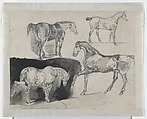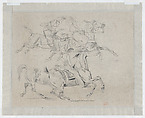On loan to The Met The Met accepts temporary loans of art both for short-term exhibitions and for long-term display in its galleries.
Four Studies of Horses (recto); Four Studies of Galloping Horses and Riders (verso)
Eugène Delacroix French
Not on view
Early in his career, Delacroix expressed his desire to master the subject of the horse. He noted in 1823, "I really must settle down seriously to drawing horses. I shall go to some stable or other every morning." No doubt inspired by his slightly older friend and fellow artist Théodore Gericault, a devoted observer of the animal and an accomplished horseman, Delacroix produced many equine studies, including this example, carefully observed and sketched directly from life.
Delacroix’s depiction of horses racing at speed on the verso of the sheet combines observation with memory and imagination. The artist undoubtedly studied the animals in motion, but then inevitably based this drawing to some degree on memory. The insertion of Ottoman and European horsemen in combat, an invention inspired by the Orientalist poetry of English author Lord Byron, takes the drawing a step further, beyond anything witnessed in life.
This double-sided sheet serves as a reminder that while Delacroix found great pleasure in sketching from nature, it was never his end goal. Rather, he regarded it as an essential component of his larger artistic process, one that infused life into his work.
Due to rights restrictions, this image cannot be enlarged, viewed at full screen, or downloaded.
This artwork is meant to be viewed from right to left. Scroll left to view more.



